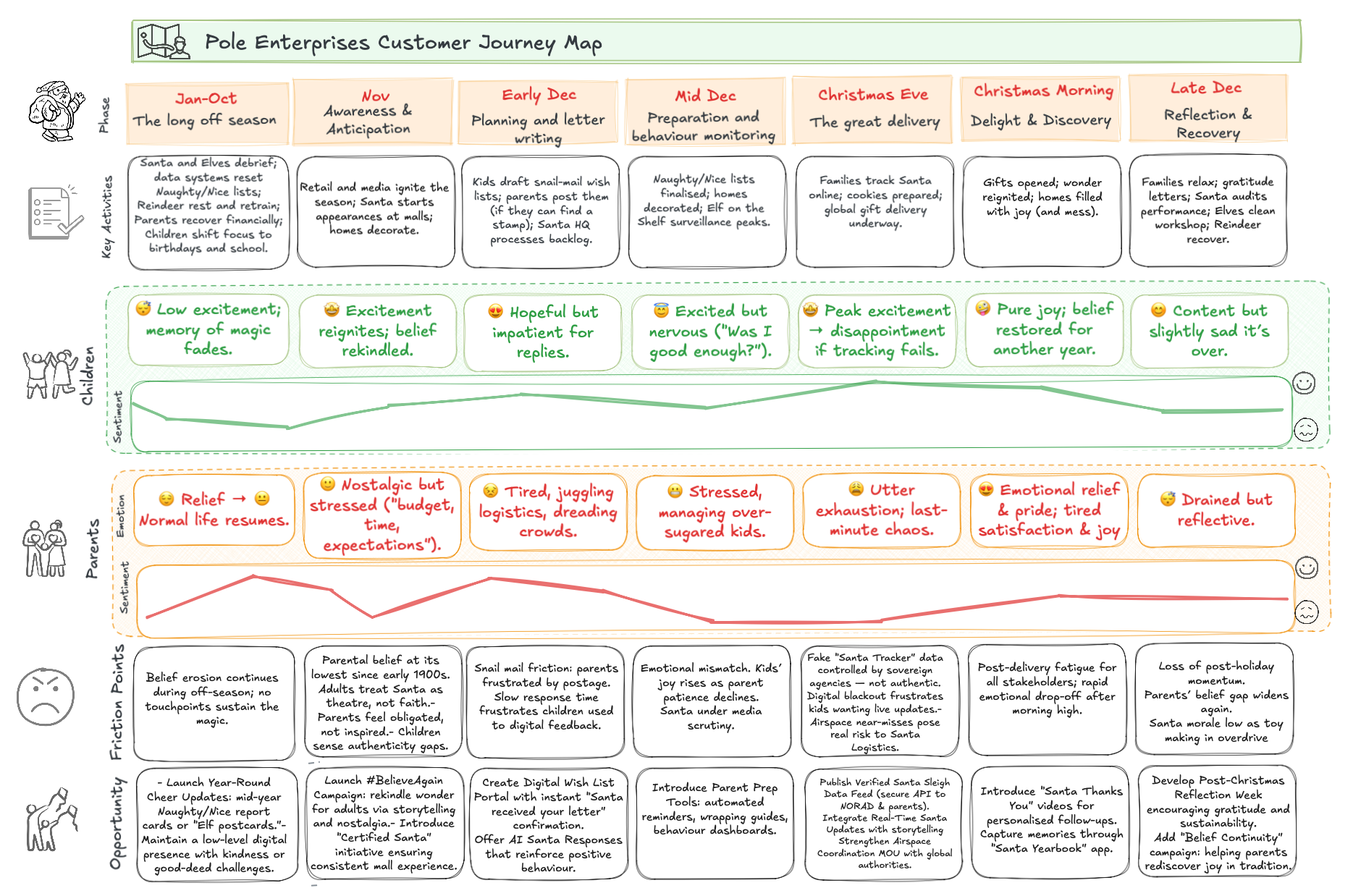Lessons in Customer Journey Mapping from the North Pole
Chapter 2: I'm going to try to bring consultant tools, templates and techniques to life using Pole Enterprises as my case study. This is 2nd in the series on how to do customer journey mapping. The 1st was Mrs Claus letter.

Background
When Mrs Claus first wrote to Consultant Café, her letter stopped us in our tracks. Here is her letter, but be warned, you WILL cry. I did. It was not only the urgency of Christmas under strain; it was the unmistakable voice of a leader watching a centuries-old miracle buckle under modern pressures.
What began as a cry for help from the North Pole became one of the most ambitious transformations we have ever been part of. We helped Mrs Claus lead a digital transformation of Santa Enterprises, modernising operations, amplifying the magic and giving the Clauses some quality time back
This series shares the lessons we learned along the way, offering practical insights every consultant can use to balance logic with wonder, and purpose with performance.
Context (of this assignment)
Before the North Pole Enterprise Board could decide where to invest, they needed to see Christmas through the eyes of those it serves most: children and their parents. For centuries, the rhythm of Christmas had relied on belief flowing freely between them. Yet that connection had started to strain under the weight of modern life. Children were still wishing, but their hopes were now sent through apps, emails, and instant messages rather than ink and envelopes. Parents were still playing their part, but the joy was competing with calendars, costs, and constant noise.
Mrs Claus could sense the change but needed to understand it more deeply, so ConsultantCafe undertook an assignment to develop a Customer Journey Map. The Customer Journey Map became Pole Enterprises Board compass. It traced how a child’s hope begins and ends. It also revealed the moments that still work: bedtime stories, shared excitement, and that quiet pause on Christmas morning when everything feels right again.
For the North Pole Enterprise Board, this map changed everything. It showed that the future of Christmas depends on restoring the relationship between children and parents, not just improving logistics. The insights drawn from their journey became the foundation for the investment decision; proof that sustainable magic starts with understanding the humans who keep believing.
What ConsultantCafe did?
ConsultantCafé took a structured but human-centred design approach to help Pole Enterprise Board see Christmas through the eyes of its customers; children and parents. Using a classic consulting method of align, discover, analyse, validate, and recommend, the work combined disciplined structure with curiosity and empathy.
Through interviews, empathy mapping, and design workshops, stories were turned into evidence the Board could act on. Across five fast weeks, ConsultantCafé built a CJM that captured joy and friction in equal measure, revealing that the greatest risk to Christmas is not operational complexity but losing its sense of wonder in an age of convenience.
Heres a CJM Approach you can modify for your next CJM Assignment.

Outcome (and the deliverable for you to download)
The outcome of the engagement was both magical and confronting. ConsultantCafé’s work revealed that the Christmas experience still shines brightly, but the glow is thinning around the edges. Parents continue to play their part, but for many, belief has softened into polite performance, something they do for their children rather than with them. Children, on the other hand, are hungry for immediacy. They want to message Santa, track his sleigh in real time, and receive instant acknowledgment that he knows who they are. The insight was simple but profound: the magic of Christmas is no longer lost in logistics, it is eroding in engagement.
The resulting journey map gave the Pole Enterprise Board more than a view of the customer experience; it offered a compass. For the first time, the Board could see where to invest in digital connection, authenticity, and the renewal of belief. It reframed the transformation challenge from one of operations to one of emotion, setting the foundation for decisions that would protect the spirit of Christmas while guiding it confidently into the digital age.

9 Lessons for all consultants undertaking CJM
If you're contemplaing undertaking a CJM for your clients, here are some tips for a seamless consultancy.
- Understand the context. Be clear why your customer wants a CJM. Know what decisions it will inform, who it’s for, and why they need it and know what a good CJM looks like (Like the examples above).
- Have a plan or approach. Use a clear method. Im happy for you to leverage the one above as a staring point. A clear method will help manage expectations, align stakeholders and demonstrate professional rigor.
- Define the right journey. Map what matters most. It’s easy to choose the wrong customer or try to map everything and everyone. A small, well-defined journey beats a sprawling mega-map. Scope ruthlessly. In this case study I did not map Elves, Reindeer, shopping mall Santas etc.
- Gather real voices. It can be hard to reach genuine customers, and there are often well-meaning impersonators. Speak with real customers and end users. Observe behaviour as well as words. Challenge assumptions with evidence.
- Map emotions, not just actions. A journey map is an empathy artefact, not a process diagram. Show what people do, think, and feel. The emotional curve is often the most persuasive insight.
- Identify moments that matter. This is hard work. Hunt for inflection points that shape trust, loyalty, or frustration. These are your levers for investment and change.
- Translate insights into action. Don’t stop at “what.” Add the “so what” and “now what.” Prioritise where to fix, invest, or innovate, and link recommendations to metrics so the map drives decisions, not decoration.
- Equip yourself. Use familiar tools (Miro, Mural, whiteboards). Templates help: empathy maps, personas, and “as-is/to-be” journeys. Techniques like storyboarding and day-in-the-life interviews keep it human.
- Avoid the classic traps. Don’t map from the organisation’s perspective. Don’t confuse a service blueprint with a customer journey. Don’t stop at insight without follow-through.





